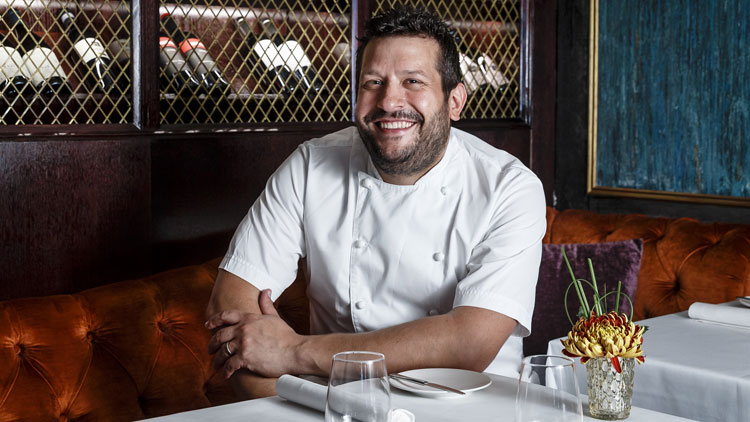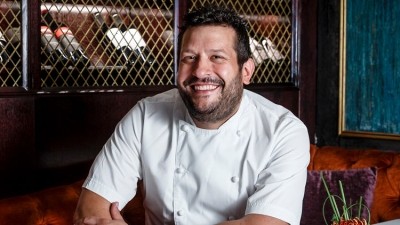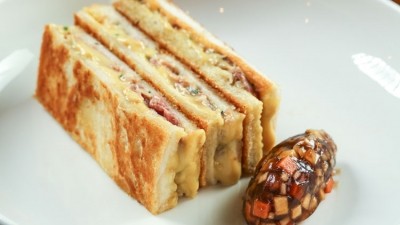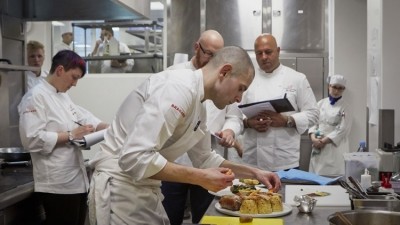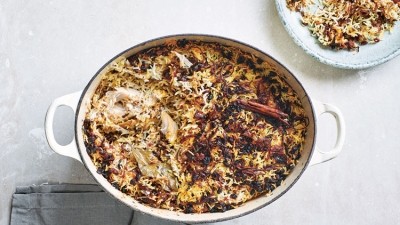Chef Masterclass: Steve Groves' veal sweetbreads and mushroom dartois
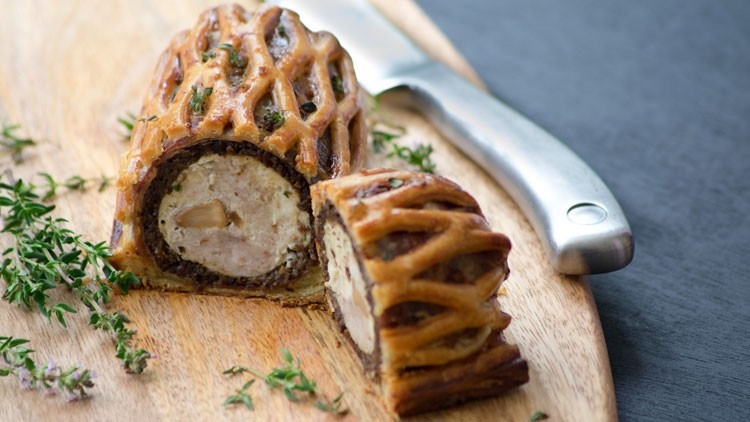
Steve Groves, who won MasterChef: The Professionals in 2009 and is now head chef at Roux at Parliament Square, is definitely at the gourmet end of the meat-in-pastry spectrum. His dartois of veal sweetbreads and mushrooms, he says, “is a tribute to Pierre Koffmann’s legendary stuffed pig’s trotter, a dish I once ate at The Berkeley with Albert Roux”.
As with Koffmann’s dish, the filling is composed of sweetbreads, mushrooms and chicken mousse, piped into a sausage shape (a ballotine, in classical French cuisine). The wrapping, however, is puff pastry, not pig skin, with the top half of the pastry cut into a lattice to give a classic dartois appearance. “It’s a Wellington, really,” says Groves – he even includes a duxelles of mushrooms – “and there are lots of possible variations. I’m using girolles at the moment, because they’re in season, but you could use morels, as in the classic Koffmann dish, or cèpes. And you don’t need to lattice the top: it works just as well with normal pastry.”
Not that Groves forgets the pig’s trotter: he uses it to make a sauce for the dartois, submerging a trotter in white chicken stock flavoured with carrot, celery, onion, bay leaf and thyme. When the trotter’s skin is soft, after a couple of hours, he removes the skin, dices it, strains and reduces the sauce, then puts the diced skin back in, sharpening the sauce with parsley, Lilliput capers and chopped pickled onion. “This will cut through all the gelatinous fat. But any full-flavoured sauce made with reduced stock and wine would be good, too.”
It is a complex dish, but none of the steps are especially difficult, particularly if you use ready-rolled puff pastry. It is not, however, a dish to be prepared in a hurry in the middle of service. “It really helps to have everything cold when you assemble the dartois,” advises Groves. “We put the ballotine in the blast chiller after each step: 10 minutes in the freezer will have the same effect. The recipe for some of the elements will make more than you need but it’s difficult to make smaller amounts and they’ll keep in the fridge for a few days.”
Groves uses thin slices of smoked pancetta to wrap the ballotine, which adds flavour “and also, because of its high fat content, it sort of crisps the pastry from the inside,” he says. “To get the pastry crisp underneath as well as on top, it’s important to use a heavy oven tray – a cast-iron skillet is even better – and make sure it’s really hot before you put the dartois on it.”
On the plate, keep it simple: it just needs a puddle of sauce and a straightforward garnish: pomme purée, perhaps, or Jersey Royals. In summer, Groves serves it with a purée of charred sweetcorn. “If you serve it as a starter, it only needs a plain salad, maybe dressed watercress,” he says. Like all classic pastry dishes, practice makes perfect. And, if the irresistible lure of meat wrapped in pastry means that dartois flies off your menu as quickly as it does in Groves’ restaurant, you will have plenty of practice.
Steve Groves’ veal sweetbread and mushroom dartois
Serves two as a main course, or four as a starter
Ingredients
For the girolles
35g unsalted butter
250g girolles, cleaned
½ clove garlic, minced
1 tsp chopped fresh thyme
1 small shallot, finely diced
For the chicken mousse
1 chicken breast, about 175g, chopped into 2cm dice
½ tsp salt
1 egg
150ml single cream
50ml double cream
For the dartois
6 very thin slices smoked pancetta
300g all-butter puff pastry
Egg wash
For the filling
100g veal sweetbreads, blanched, peeled, chilled and cut into 1cm pieces
1 tsp chopped chives
50g girolle mix
130g chicken mousse
For the mushroom duxelles
500g chestnut (or button) mushrooms, sliced
1 small onion, finely diced
1 small garlic clove, crushed
50ml dry madeira (or sherry)
50g unsalted butter
1 tsp chopped rosemary and thyme
Method
1. Prepare the girolles. Melt the butter and sauté the girolles for two minutes. Add garlic, thyme and shallot and cook until soft. Chill, chop roughly and season with salt.
2. Prepare the chicken mousse. Ensure everything is well chilled, including the food processor bowl. Blend the chicken with the salt until finely chopped, then add the egg and blend, adding the single cream in a thin stream until the mixture is smooth. Press through a fine sieve, then stir in the double cream and store in the fridge until needed.
3. Prepare the filling. Mix everything together, cut a 5.5cm opening in a piping bag and pipe into a sausage shape. Wrap and freeze.
4. Prepare the duxelles. Heat the butter in a pan over a medium heat, add the shallot and garlic and cook until translucent, stirring occasionally. Turn up the heat and add the mushrooms, then cook until the mushrooms are dry. Add the herbs and madeira and reduce until the pan is dry again. Transfer to a food processor and blend, then cool completely.
5. To assemble, take a 35cm x 35cm piece of cling film, lay it flat on a work surface, lay the pancetta lengthways away from you, overlapping slightly: they should be slightly wider than the ballotine. Spread a ½cm layer of duxelles on the pancetta and lay the ballotine in the centre. Fold the edges up and roll tightly in the cling film, tuck the ends in and refrigerate.
6. Heat a baking tray in an oven to 190°C. Roll the puff pastry to a 3mm rectangle and cut in half. Run a lattice cutter across one half of the pastry. Unwrap the ballotine. Place the uncut pastry on a sheet of silicone paper slightly bigger than the pastry. Brush with egg wash, put the ballotine in the centre, lay the pastry lattice over the top, and press lightly to seal around the edges. Brush the top with egg wash then trim the edges.
7. Slide onto the oven tray and bake for about 30 minutes (to a core temperature of 65°C). Allow to rest for 10 minutes before slicing into four and plating.
